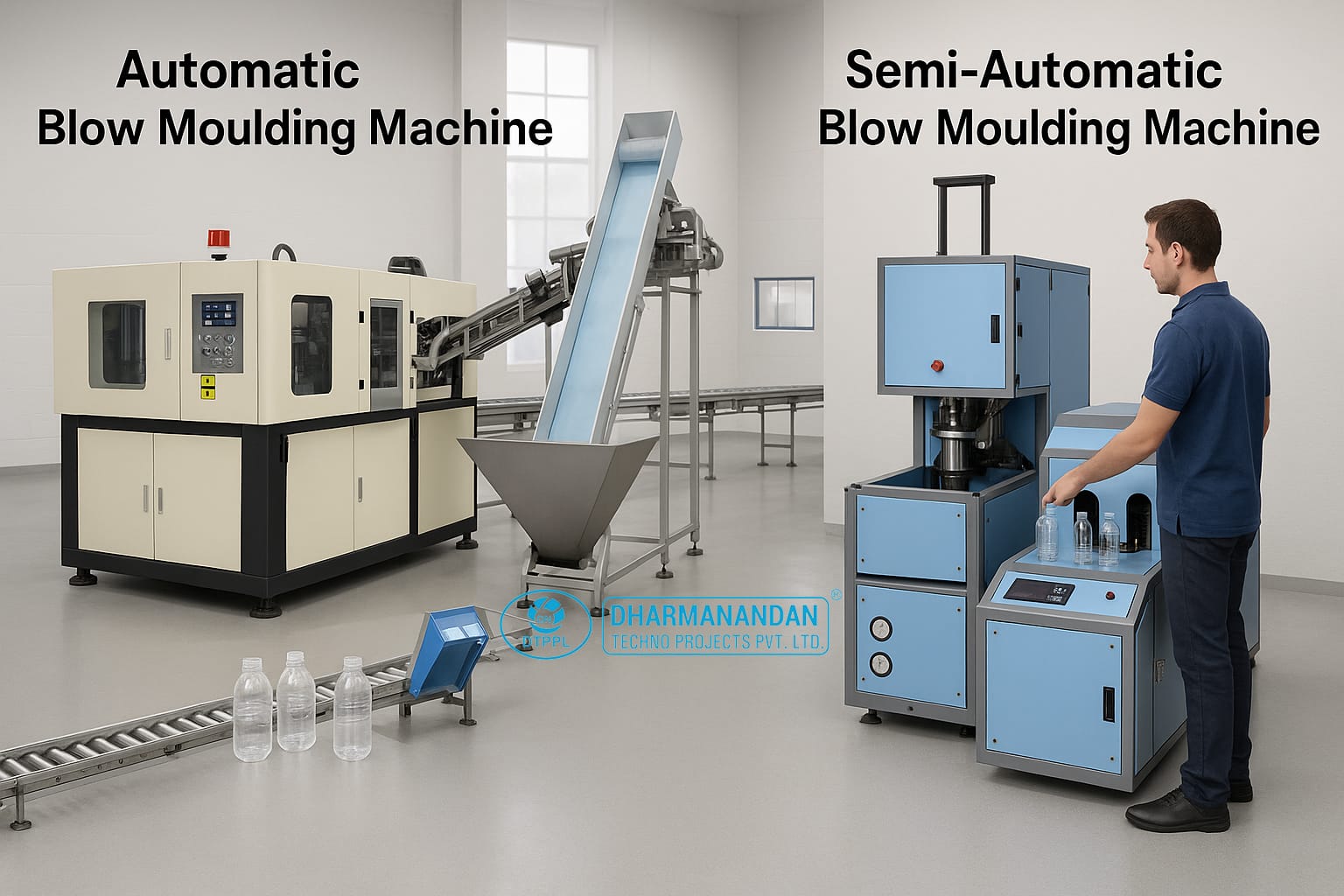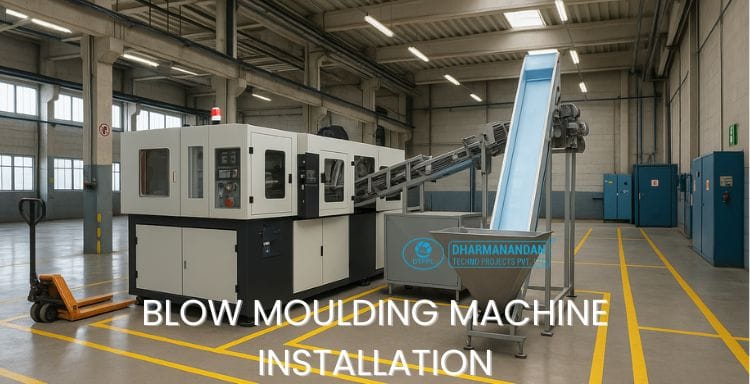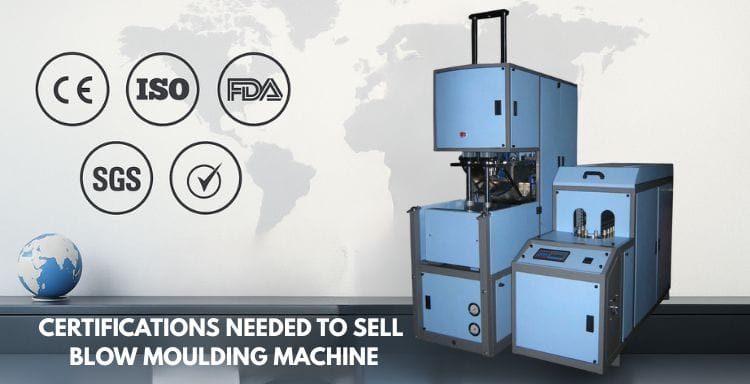
Table of Contents
Blow Moulding Machine: Q&A Guide for Automatic & Semi-Automatic Models
July 24, 2025
The global demand for blow moulding machines, including automatic and semi-automatic blow moulding machines, is rising rapidly due to increased plastic packaging, container manufacturing, and cost-effective production of hollow plastic parts. Whether you’re a startup entrepreneur in India, an overseas buyer in Africa, or an industrial packager in the Middle East, understanding every business aspect — from setup cost to maintenance, market trends, and export dynamics — is crucial before investing.
This 50-question guide provides practical, technical, and commercial answers for anyone planning to enter or expand in the blow moulding machine industry. All pricing inquiries should be directed to Dharmanandan Techno Project Pvt. Ltd., a trusted name in blow moulding machine solutions.
General Understanding & Machine Basics
What is a blow moulding machine and how does it work?
A blow moulding machine is used to manufacture hollow plastic components like bottles, jars, tanks, and containers. The process involves melting plastic, forming a parison (tube-like structure), and inflating it inside a mold to get the desired shape. Machines are typically categorized as automatic or semi-automatic based on the level of human involvement.What is the difference between automatic and semi-automatic blow moulding machines?
An automatic blow moulding machine handles the full production cycle (feeding, heating, blowing, and ejection) without manual intervention, offering higher production speed and consistency. A semi-automatic blow moulding machine, on the other hand, requires manual loading/unloading and may need more manpower, making it suitable for low to medium production.
What types of plastic materials can be used in blow moulding machines?
Common plastics used in blow moulding machines include HDPE, LDPE, PET, PP, and PVC. The choice depends on the product being manufactured (e.g., food-grade PET for beverages, HDPE for detergent bottles).
What are the main components of a blow moulding machine?
A blow moulding machine consists of:
- Extruder or injection unit
- Parison or preform former
- Blow pin or stretch rod
- Clamping system
- Mould cavity and mold cooling
- Control panel (PLC or manual)
Which industries commonly use blow moulding machines?
Industries using blow moulding machines include:
- Packaged drinking water and soft drinks
- Pharmaceuticals and cosmetics
- Lubricants and chemicals
- Agrochemicals and fertilizers
Household cleaning product manufacturing
What is the production capacity of an automatic blow moulding machine?
Production capacity varies by model. Automatic blow moulding machines can produce 700 to 2,000+ bottles per hour depending on bottle size, machine configuration, and number of cavities. Contact Dharmanandan Techno Project Pvt. Ltd. for exact specifications.
Can a semi-automatic blow moulding machine be upgraded later to automatic?
Yes, in many cases. Modular machines can be upgraded by adding automation components like robotic arms, conveyors, or automatic preform feeders. However, it’s best to confirm upgrade feasibility with the manufacturer directly.
What is the typical electricity consumption of a blow moulding machine?
Electricity usage depends on machine type and size. On average:
- Semi-automatic blow moulding machine: 5 to 15 kW/hour
- Automatic blow moulding machine: 15 to 35 kW/hour
Using energy-efficient servo motors can reduce consumption.

How much factory space is required for installing a blow moulding machine?
For a single semi-automatic blow moulding machine, you may need around 400–600 sq. ft., including space for raw material storage and cooling. Automatic setups with multiple cavities may require 1000–2000+ sq. ft. Always plan for ventilation, compressed air units, and mold storage.
What are the standard safety features in a blow moulding machine?
Key safety features in modern blow moulding machines include:
- Emergency stop buttons
- Mold lock detection
- Temperature and pressure alarms
- Door interlocks
- Automatic shutdown systems
- Servo controls for reduced risk of human error
Business Setup, Costing & Market Demand
What is the investment required to start a blow moulding machine business in India?
Starting a business with a semi-automatic blow moulding machine may require an investment of ₹8–20 lakhs, while an automatic blow moulding machine setup with higher output can range between ₹25 lakhs to ₹1 crore+. This includes machine cost, molds, utilities, manpower, and installation. For accurate pricing, always contact Dharmanandan Techno Project Pvt. Ltd.
What are the main cost components when setting up a blow moulding machine unit?
The key cost components include:
- Machine cost (automatic or semi-automatic blow moulding machine)
- Air compressor and chiller unit
- Moulds for different bottle sizes
- Installation and training
- Factory rent or construction
- Electrical and water utilities
- Working capital for raw materials
How much does a blow moulding machine cost in India?
The price of a semi-automatic blow moulding machine starts from around ₹5–8 lakhs, while an automatic blow moulding machine may range from ₹15 lakhs to ₹50 lakhs+ depending on features, capacity, and automation. For exact prices and offers, contact Dharmanandan Techno Project Pvt. Ltd.
Is it profitable to set up a blow moulding machine business in 2025?
Yes. With increasing demand for plastic bottles, jars, containers in the FMCG, pharma, and packaging sectors, setting up a blow moulding machine business is highly profitable, especially in Tier-2 and Tier-3 cities and export markets. The return on investment (ROI) can be achieved within 12–24 months.
Which Indian cities have high demand for blow moulding machines?
Cities like Ahmedabad, Mumbai, Bhiwandi, Delhi, Indore, Hyderabad, Bengaluru, Kolkata, Pune, and Coimbatore have strong industrial clusters with regular demand for blow moulding machines due to their packaging, chemical, or beverage industries.
Is there export demand for Indian-made blow moulding machines?
Yes. Indian blow moulding machines, especially automatic and semi-automatic models, are in high demand across Africa (Kenya, Nigeria, Ghana), Gulf countries (UAE, Saudi Arabia, Oman), Latin America, and parts of Southeast Asia due to affordability and customizability.

What certifications are needed to sell blow moulding machine-made products globally?
For global supply, ensure your blow moulding machine setup follows certifications like CE (for Europe), FDA (for food-grade packaging), and ISO 9001. Machines should support food-grade plastics and safe manufacturing practices.
Can blow moulding machines be used for carbonated drink bottles?
Yes, but only certain types of automatic blow moulding machines with high-pressure capabilities and specific molds are suitable for carbonated drink PET bottles, as they require strong structural integrity.
How many operators are required for a semi-automatic blow moulding machine?
Typically, 1 to 2 trained operators are sufficient per semi-automatic blow moulding machine. For multiple machines or a continuous setup, 3-shift staffing may be required to optimize production.
How long does it take to install and commission a blow moulding machine setup?
Depending on the complexity, it takes 1 to 3 weeks to install and fully commission an automatic or semi-automatic blow moulding machine. This includes training, mold setup, and production trial runs.
What are the routine maintenance requirements for a blow moulding machine?
Routine maintenance of a blow moulding machine includes:
- Daily cleaning of molds and preform feed areas
- Weekly checks on pneumatic lines and hydraulic fluid
- Monthly lubrication of moving parts
- Periodic inspection of electrical controls and heaters
This ensures longer life, higher uptime, and reduced breakdowns.
How often should molds be replaced in blow moulding machines?
Blow moulding machine molds typically last for 500,000 to 1 million cycles, depending on material and care. Regular polishing, temperature monitoring, and cleaning extend mold life. For high-volume production, mold quality is critical.
What factors affect the output capacity of a blow moulding machine?
Key factors include:
- Type of machine (automatic vs semi-automatic)
- Number of cavities in the mold
- Preform heating time and cooling system efficiency
- Operator skill (for semi-automatic models)
An automatic blow moulding machine can produce up to 1800–4000 bottles per hour, while a semi-automatic model ranges around 600–1200 bottles/hour.
What materials are compatible with blow moulding machines?
Blow moulding machines typically support PET, HDPE, PP, LDPE, and PVC, depending on machine configuration. PET is most commonly used for water, juice, and soft drink bottles. Material selection impacts heating parameters and output.
How do I choose the right mold for my blow moulding machine?
Mold selection depends on:
- Bottle shape and volume (100ml to 5L or more)
- Number of cavities (single, double, 4-cavity, 6-cavity)
- Material (aluminum, beryllium copper, etc.)
Discuss your requirements with Dharmanandan Techno Project Pvt. Ltd. for custom molds.
How energy-efficient are automatic blow moulding machines?
Modern automatic blow moulding machines are designed with servo motors, variable-frequency drives (VFDs), and infrared heating for optimal energy savings—some offer 30–40% lower power consumption than older models.
What safety features are built into blow moulding machines?
Standard safety features include:
- Emergency stop systems
- Infrared sensor shutdown on door opening
- Auto-cutoff for overheating
- Hydraulic and air pressure failsafe alerts
What are the signs that a blow moulding machine needs servicing?
Early signs include:
- Inconsistent bottle quality
- Prolonged heating or cooling time
- Air or hydraulic leaks
- Abnormal sounds or vibration
Regular checks prevent machine downtime and defective output.
Can a single blow moulding machine make different bottle sizes?
Yes. Blow moulding machines, especially semi-automatic models, can accommodate interchangeable molds, allowing production of various sizes (e.g., 200ml, 500ml, 1L, 2L). This provides flexibility for small to mid-scale manufacturers.
How do I reduce waste and defects in blow moulding machine production?
To reduce scrap and defective bottles:
- Maintain precise preform heating control
- Use quality preforms and consistent air pressure
- Perform regular mold alignment checks
- Train operators on best practices
Modern machines also support AI-based fault detection and QC logs.
Business Insights, Export Potential, Smart Manufacturing & Buyer Tips
What are the common mistakes to avoid when buying a blow moulding machine?
Some mistakes include:
- Choosing low-cost machines without support or warranty
- Ignoring mold compatibility and output capacity
- Underestimating after-sales service needs
- Not verifying the manufacturer’s export experience
Always work with trusted partners like Dharmanandan Techno Project Pvt. Ltd. for guidance and long-term reliability.
Can a blow moulding machine be integrated into a smart factory setup?
Yes. Modern automatic blow moulding machines can integrate with IoT systems, SCADA, and cloud-based monitoring, offering real-time production data, alerts, and maintenance tracking—perfect for Industry 4.0 environments.
Which countries have strong demand for Indian blow moulding machines?
Indian blow moulding machines have growing demand in:
- African markets: Nigeria, Kenya, Ghana
- Middle East: UAE, Saudi Arabia, Oman
- South Asia: Bangladesh, Nepal, Sri Lanka
- Southeast Asia: Vietnam, Philippines, Indonesia
- Latin America: Peru, Ecuador, Chile
India’s price-quality balance makes it globally competitive.
What certifications should a blow moulding machine have for export?
Key certifications include:
- CE (Europe)
- UL/CSA (USA/Canada)
- ISO 9001 for quality assurance
GMP compliance for food-grade applications
What upgrades can improve the performance of existing blow moulding machines?
Upgrades include:
- Servo-driven stretching for faster cycle time
- Infrared heating systems for energy savings
- Touchscreen PLC controls for better operator control
- Auto-lubrication units for hassle-free maintenance
How does automation in blow moulding machines reduce labor costs?
Automatic blow moulding machines eliminate manual loading, unloading, and heating control. One operator can run multiple machines, saving up to 40–60% in labor costs over semi-automatic setups.
Are Indian blow moulding machines suitable for export-level production?
Yes. Machines made by Dharmanandan Techno Project Pvt. Ltd. are widely used by global brands in mineral water, pharma, edible oil, and chemical packaging—meeting international standards in speed, safety, and quality.
What is the typical ROI timeline for a blow moulding machine investment?
Depending on scale and market demand, ROI can be achieved within 8–18 months. Factors include bottle cost vs. selling price, production volume, and preform availability.
Can I run both transparent and colored bottles on the same blow moulding machine?
Absolutely. Both automatic and semi-automatic blow moulding machines can handle different bottle colors, as long as the preforms are compatible and molds are cleaned properly between batches.
How does Dharmanandan Techno Project Pvt. Ltd. support international blow moulding machine buyers?
They provide:
- Pre-sales consultation based on your market needs
- Customization of machines and molds
- Global shipping and export documentation
- Remote commissioning and training support
- Spare parts and after-sales service
For pricing and consultation, please contact them directly.
Can I get financial assistance or EMI options for purchasing a blow moulding machine in India?
Yes. Many buyers opt for business loans, MSME schemes, or leasing options. Contact Dharmanandan Techno Project Pvt. Ltd. for current financing solutions
How easy is it to scale operations with multiple blow moulding machines?
Automatic blow moulding machines are ideal for scalable production. You can easily set up multiple lines with centralized air supply, mold sets, and conveyors. This modularity allows for phased expansion with low disruption.
What’s the average lifespan of a blow moulding machine with regular maintenance?
With proper care, a quality blow moulding machine can last 10–15 years. Preventive maintenance, timely part replacements, and clean working environments significantly extend machine life.
Do suppliers provide operator training for blow moulding machines?
Yes. Reputed suppliers like Dharmanandan Techno Project Pvt. Ltd. provide onsite or remote training, covering:
- Preform loading
- Mold changes
- PLC control usage
- Basic troubleshooting
This ensures your team can run the machine efficiently from day one.
What are the typical mold changeover times in a blow moulding machine?
For semi-automatic blow moulding machines, mold changeover takes 30–60 minutes. In automatic machines with quick-lock systems, it can be as fast as 10–20 minutes, enhancing flexibility for multiple product SKUs.
Read Our Article: Customizing Blow Moulding Machines for Water Treatment Plant Packaging
Can I use a blow moulding machine to produce square or custom-shaped bottles?
Yes. Blow moulding machines can produce round, square, flat, or specialty shapes with the right mold design. Custom mold development is available from manufacturers like Dharmanandan Techno Project Pvt. Ltd.
What should be the humidity and temperature control in the blow moulding machine area?
Maintain moderate humidity (45-60%) and ambient temperature around 25–30°C to avoid preform defects and ensure uniform blowing. Well-ventilated, dust-free areas are ideal for efficient operations.
How is semi automatic blow moulding machine operation different from fully automatic?
Semi-automatic machines require manual loading and unloading, while automatic blow moulding machines automate these steps. Automatic machines offer higher speed, less labor, and consistent quality, suitable for large-scale units.
Are there blow moulding machines suitable for startup-scale mineral water bottle production?
Yes. You can start with a 2-cavity semi-automatic blow moulding machine for 200ml to 1-liter bottles. It offers low investment, 800–1,200 bottles/hour output, and fast setup—perfect for startups and rural bottling units.
Why is Dharmanandan Techno Project Pvt. Ltd. a reliable name for blow moulding machines?
Because we offer:
- Wide product range: semi and fully automatic machines
- Customization for various bottle shapes and sizes
- Strong after-sales and spare support
- Global export capabilities with certifications
- Trusted by startups and MNCs alike
For accurate pricing and configuration, contact them directly.
Semi Automatic Blow Molding Machine
Capacity: 1100 BPH to 1200 BPH (2 Cavity)
Capacity: 2200 BPH to 2400 BPH (4 Cavity)
Conclusion: A One-Stop Guide for Blow Moulding Machine Buyers
Whether you’re launching a mineral water plant in India, exporting to Africa or Middle East, or upgrading your cold drink or pharma bottling line, understanding blow moulding machines is essential.
From automatic to semi-automatic, knowing setup needs, mold options, maintenance, and finance will help you make informed decisions. And with industry-trusted names like Dharmanandan Techno Project Pvt. Ltd., you gain not only advanced machines but also partner-driven support for growth, compliance, and scalability.
For accurate pricing, customization, or consultation, contact Dharmanandan Techno Project Pvt. Ltd.—your trusted blow moulding machine supplier.
About Author

Director – Global Marketing and Sales
Mr. Bhavesh from Dharmanandan Techno Projects Pvt. Ltd. has played a pivotal role in elevating the DTPPL brand to the global stage, leveraging his exceptional expertise in marketing and communications. He is committed to helping clients achieve significant growth while strengthening their own brands. Dharmanandan Techno Projects Pvt. Ltd. is a leading manufacturer and supplier of water purification systems and turnkey solutions for mineral water plants. With years of experience in designing and delivering high-quality water treatment solutions, the company provides end-to-end services, including system design, installation, maintenance, and ongoing support. Specializing in scalable and customizable water plants, DTPPL has successfully served industries worldwide, ensuring clean and safe drinking water across diverse applications.




